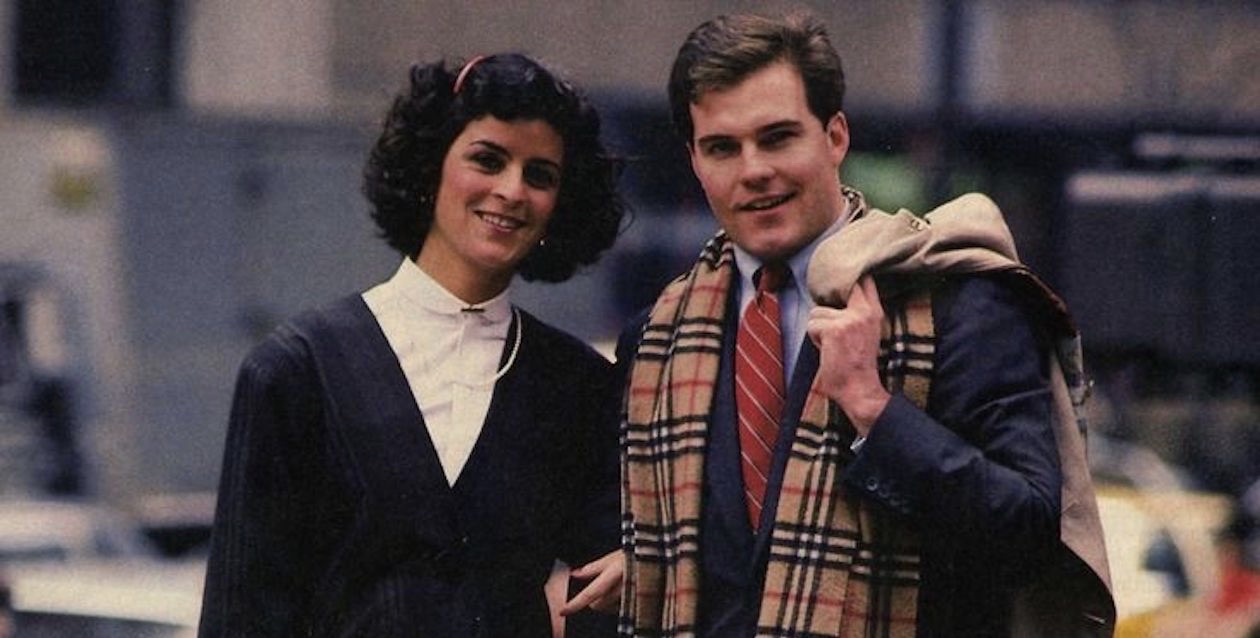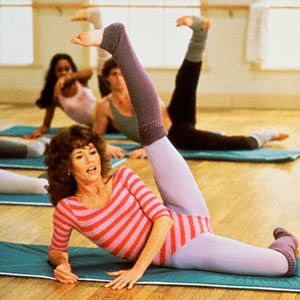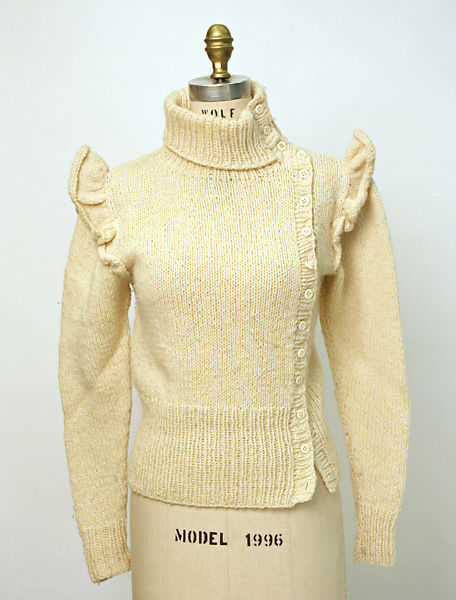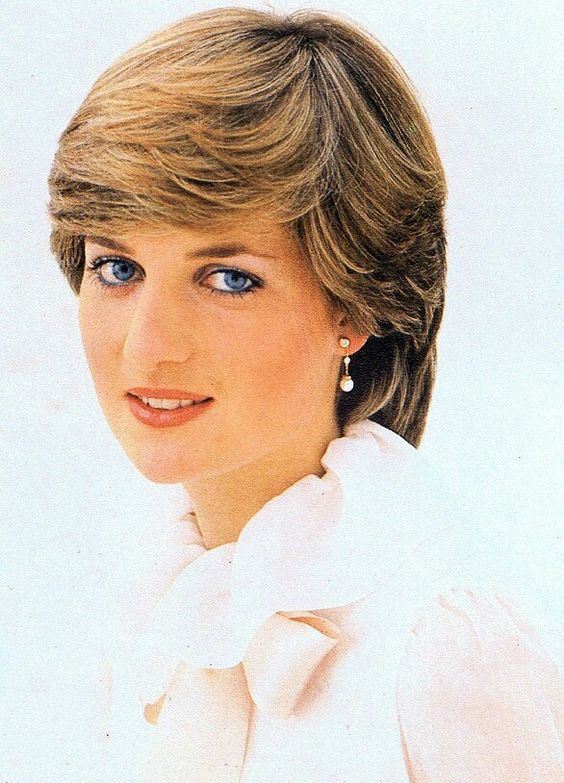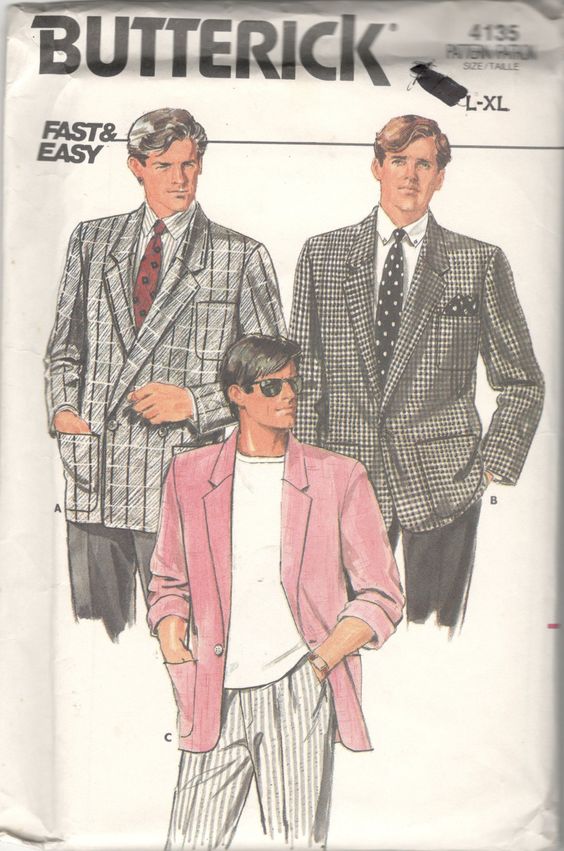OVERVIEW
In the 1980s, bigger meant better across the board in fashion. From women’s shoulder pads to men’s power suits to bold colors and patterns for men, women and children, there was nothing understated about fashion in the eighties.
Womenswear
A decade typified by its “power dressing,” the 1980s actually opened with stylish sportswear and the soft “New Romantics” style. Carrying on from the late 1970s trend for sportswear and encouraged by a fitness craze, women increasingly wore stylish gym wear in their day-to-day life. This was captured in Jennifer Beals’ attire in the 1983 movie Flashdance (Fig. 1). Dance-wear inspired fashion including off-the-shoulder sweatshirts and leggings, while Jane Fonda’s exercise videos also encouraged these styles (Fig. 2).
Norma Kamali continued to produce fashionable sportswear using comfortable materials such as jersey. Meanwhile designers such as Donna Karan and Azzedine Alaïa moved to using stretchy fabrics such as Lycra for body-conforming clothing. Editor Kathryn Hennessy notes how this produced a significant shift how fashion was worn in Fashion: The Ultimate Book of Fashion and Style: “Women’s bodies were now shaping the clothes, rather than clothes shaping the body” (388). The dresses by Donna Karan and Azzedine Alaia (Figs. 3-4) show how dresses conformed to the body while the ensemble by Versace (Fig. 5) is an example of how sportswear made its way into high fashion. The ensemble features a popular piece from the eighties: a bodysuit.
In the early 1980s, the romantic style typified by the prairie dresses of the 1970s continued. Princess Diana’s fairy-tale wedding dress by David and Elizabeth Emanuel exemplified this trend [see “Fashion Icon” section below]. Puffed sleeves, oversized accessories such as belts and bows, and historical references made bold statements. Vivienne Westwood gave this look an edge with her Pirate Collection in 1981 (Fig. 6) and was adopted by bands and club-goers in London as the “New Romantic” look (Hennessy 390).
Fig. 3 - Donna Karan (American, 1948-). Dress, 1987. Wool. New York: The Metropolitan Museum of Art, 1992.258.1. Gift of Donna Karan Co., 1992. Source: The Metropolitan Museum of Art
Fig. 4 - Azzedine Alaïa (French, 1935–2017). Dress, Fall/Winter 1986-87. Synthetics. New York: The Metropolitan Museum of Art, 2007.82. Millia Davenport and Zipporah Fleisher Fund, 2007. Source: The Metropolitan Museum of Art
Fig. 5 - Gianni Versace (Italian, 1946–1997). Ensemble, Spring/Summer 1980. Silk, cotton, polyester, jersey, leather. New York: The Metropolitan Museum of Art, 1980.399.2a–f. Gift of Gianni Versace, 1980. Source: The Metropolitan Museum of Art
Fig. 6 - Vivienne Westwood (British, 1941-). Pirate Collection, Fall-Winter 1981-82. Figured cotton and rayon ensemble, with printed plain weave cotton shirt and sash, muslin stockings, and hat of stiffened felt trimmed with leather and braid. London: Victoria & Albert Museum, T.334 to I-1982. Given by the designer. Source: V&A
Fig. 7 - Emanuel Ungaro (French, 1933-). Ensemble, Spring/Summer 1985. Silk, plastic, glass, metal. New York: The Metropolitan Museum of Art, 1989.333.22a–f. Gift of Anne H. Bass, 1989. Source: The Metropolitan Museum of Art
Fig. 8 - Thierry Mugler (French, 1948-). Suit, 1986. Wool. New York: The Metropolitan Museum of Art, 1999.56.3a–c. Gift of Mr. and Mrs. Michael Lewis, 1999. Source: The Metropolitan Museum of Art
As the decade progressed, so-called “power dressing” began to dominate. This reflected a shift in women working in high-powered positions and using fashion to be taken seriously. Padded shoulders and bold accessories made up this look; a typical patterned look is seen in the suit by Emanuel Ungaro (Fig. 7). Hennessy writes,
“As more women entered traditionally male-oriented work environments, they found it advantageous to dress as though they were in command, and sure of their sexuality. This meant jackets with heavily padded shoulders, vibrant colours, big hair-dos, bold accessories, and shoes with pointed toes and spiked heels.” (396)
As part of this move towards bold dressing it was important to be seen wearing designer clothes. These designers embraced the power suits and added their own twist. Thierry Mugler’s wide-shouldered suit made a slight alteration to the popular peplum look (Fig. 8). However, designer personalities also became a focal point of fashion in the early 1980s as each designer promoted a signature style (Hennessy 392). Some of these personality-driven brands included Christian Lacroix, Gianni Versace, Jean Paul Gaultier and Karl Lagerfeld for Chanel.
The latter took over the storied fashion house of Chanel in 1983. Lagerfeld was hired to increase sales and within a year, Chanel was one of the most fashionable brands again. Of Lagerfeld’s beginning at Chanel, Amy de la Haye and Andrew Tucker write in Costume and Fashion: A Concise History,
“Lagerfeld’s brief was to increase sales by attracting a new, youthful market, while retaining the loyalty of Chanel’s traditional customers. From the outset he exploited Chanel’s signature designs, sometimes paying homage to her classic styles and at other times parodying them without mercy. Within a year the House of Chanel was once again in the forefront of fashion.” (Laver 273-274)
In his first year, he made a leather jacket with the signature Chanel gold buttons and square breast pockets (Fig. 9). Later in the decade, he designed a typical black dress with cream trim in a thoroughly modern silhouette (Fig. 10). Christian Lacroix, who had opened his couture house in 1975, also expertly tapped into the fashion market and created extravagant, over-the-top clothing for a wealthy clientele (Laver 280). Inspired by historical dress and craftsmanship, his designs displayed the signatures of 1980s such as big skirts (Fig. 11) and balloon sleeves. He launched a ready-to-wear line in 1988.
Fig. 9 - Karl Lagerfeld for the House of Chanel (French, 1933–2019). Evening Ensemble, 1983. Leather, metal, synthetic. New York: The Metropolitan Museum of Art, 2006.77.1a, b. Gift of Mary Bernet Kavanagh, 2006. Source: The Metropolitan Museum of Art
Fig. 10 - Karl Lagerfeld for the House of Chanel (French, 1933–2019). Dress, Spring/Summer 1985. Silk. The Metropolitan Museum of Art, 1989.333.4a–c. Gift of Anne H. Bass, 1989. Source: The Metropolitan Museum of Art
Fig. 11 - Christian Lacroix (French, 1951-). Dress, 1980s. Silk, cotton. New York: The Metropolitan Museum of Art, L.2019.43.13a–c. Promised Gift of Sandy Schreier. Source: The Metropolitan Museum of Art
Though the dominant trend of the 1980s was bigger is better, taffeta and bright colors, other designers emerged and created their own styles. For daywear, American designers such as Perry Ellis and Ralph Lauren turned to classic styles menswear styles such as blazers, button downs and hand-knit sweaters to create casually elegant womenswear (Figs. 12-13). These styles came to represent casual American style and were adopted as a “preppy” style in the US (“preppy” referencing the elite preparatory schools attended by wealthy teens).
The style was influenced by traditional Ivy League and Seven Sisters style, as well as the dress of early twentieth-century British aristocrats (Laver 276). In her book Seven Sisters Style, Rebecca C. Tuite writes, “Lauren’s interpretation of the collegiate look was never a costume or a disguise; it was an understated appreciation of good, classic style” (104). The plaid Perry Ellis suit (Fig. 14) pays homage to late 1940s and early 1950s collegiate style. Tuite continues to note that the look was interpreted in many ways throughout the decade: “The preppy fashions of the 1980s ranged from understated and classic to gaudy and ironic” (107).
On the other side of the world, a shocking new type of fashion emerged from Japan. De la Haye and Tucker write, “The clothes of innovative Japanese designers, who continued to show in Paris, offered a stark and often startling alternative to Western styles” (Laver 277). Designers such as Comme des Garçons’ Rei Kawakubo and Yohji Yamamoto employed deconstruction, exaggerated proportions and to transform how clothing interacted with the body (Hennessey 400, Fig. 13). This resulted in shocking styles that differed from the typical styles of the decade. Their predominant use of black would continue into the early 1990s as the power dressing of the eighties began to evolve towards the minimalism of the subsequent decade.
Fig. 12 - Perry Ellis Sportswear Inc. (American, 1940–1986). Ensemble, Fall/Winter 1981-82. Wool. New York: The Metropolitan Museum of Art, 1996.61.2a, b. Gift of Roz Gerten Jacobs, 1996. Source: The Metropolitan Museum of Art
Fig. 13 - Ralph Lauren (American, 1939-). The Best of Ralph Lauren Ads, 1980s. Source: Pinterest
Fig. 14 - Perry Ellis Sportswear Inc. (American, 1940–1986). Suit, Fall/Winter 1981-82. Wool. New York: The Metropolitan Museum of Art, 1996.61.4a, b. Gift of Roz Gerten Jacobs, 1996. Source: The Metropolitan Museum of Art
Fig. 15 - Comme des Garçons (Japanese, 1942-). Ensemble, 1983–84. Wool. New York: The Metropolitan Museum of Art, 2016.547a, b. Purchase, Friends of The Costume Institute Gifts, 2016. Source: The Metropolitan Museum of Art
Fashion Icon: Princess Diana
One of the most enduring icons of eighties style is Princess Diana, the young woman who famously married into the British royal family in July 1981 (Fig. 1). The world instantly embraced the new princess and her style reflected popular trends throughout the decade.
Before getting married, Diana was considered a “Sloane Ranger,” the UK’s answer to the preppy look and so-named for the affluent central London Sloane Square address many of them lived near. Pearls, pie-crust blouses, flowery Laura Ashley skirts and patent pumps were in her arsenal during this time. In her first portrait for British Vogue (Fig. 2), she wore a soft pink blouse with a frilly collar by David and Elizabeth Emanuel that typified the early eighties romantic look.
Her wedding dress by David and Elizabeth Emanuel is, of course, one of the most enduring fashion moments of the 1980s (Fig. 1). In Diana, Her Life in Fashion, Georgina Howell notes that this gown foreshadowed Diana’s fashion influence:
“In a postscript that presaged Diana’s future power over the fashion industry, bridal manufacturers applied themselves to duplicating the dress in record time. Within five hours of the wedding there were already two copies of the dress in Oxford Street stores.” (40)
With its giant puffed sleeves and a 25-foot train and ample bows and lace, the gown became the epitome of eighties wedding style.
Fig. 1 - Photographer unknown. Elizabeth Emanuel's Scrapbook from Diana and Charles' Wedding, July 1981. Source: Pinterest
Fig. 2 - 1st Earl of Snowdon Antony Charles Robert Armstrong Jones (British, 1930-2017). Engagement portrait, published in Vogue, February 1981. Source: Pinterest
Fig. 3 - Photographer unknown. Princess Diana in a dress by the Emanuels in Saudi Arabia, November 1986. Source: Pinterest
Fig. 4 - Photographer unknown. Diana in Catherine Walker, 1985. Source: Pinterest
Fig. 5 - Photographer unknown. Tatters dress in Japan, 1986. Source: Pinterest
Fig. 6 - United States Federal Government. Princess Diana dancing with John Travolta in the entrance hall at the White House., 11 November 1985. Ronald Reagan Library. Source: Wikimedia
As 1980s style progressed, so did Diana’s. Royal style requires a significant amount of thought and Diana managed to do this, while also following eighties fashion trends. Kensington Palace writes in Diana: Her Fashion Story, “Diana’s style was overtly glamorous by the mid-1980s. She adopted glitzy embellishments and wide shoulder pads” (8). On a tour of Saudi Arabia in 1986, her Emanuel evening gown had huge puffed shoulders, a giant striped bow and black and white color-blocking, all signature eighties trends (Fig. 3). By this time, she had developed relationships with several designers including Bellville Sassoon, Bruce Oldfield and Catherine Walker. Walker especially created appropriate “power-suits” for the Princess for any occasion (Fig. 4).
All of these designers understood the importance of diplomatic dressing and helped Diana develop her own thoughtful way of dressing for an occasion. This required different approaches for different events. Kensington Palace explains,
“For overseas tours, Diana needed regal gowns that conveyed diplomatic messages. By contrast, when visiting hospitals or schools, she preferred outfits that reflected approachability and warmth, and would wear accessories that children could play with. She abandoned the royal protocol of wearing gloves, as she liked to make direct contact when shaking or holding hands. She also stopped wearing hats, as she said, ‘you can’t cuddle a child in a hat.’” (10)
Royal dressing requires extreme attention-to-detail and Diana took cues from the Queen’s expertise while also finding her own way forward. She incorporated current fashions more readily and took more risks, mostly to praise from adoring fans. She was seen wearing red dots and wide-shoulders on a tour of Japan in 1986 (Fig. 5).
Some of the most iconic fashion moments of the 1980s are thanks to “Shy Di.” From her off-duty knitted sweaters to dancing with John Travolta in an off-the-shoulder midnight blue Victor Edelstein gown at the White House (Fig. 6), to bold patterns and bright colors, Diana’s fashion influence was felt throughout the decade, and indeed until her death in 1997.
Menswear
Fashion for men in the 1980s largely followed the trends in womenswear. Like women, there was a craze for fitness wear, classic American workwear, preppy styles and “power dressing” (Laver 276). Many of the big names in women’s fashion also began designing men’s fashion in the 1980s:
“The 1980s also saw many designers expand their ranges to embrace menswear. These included Mugler (1980), Comme des Garçons (1983), Jean-Paul Gaultier (1984) and Karl Lagerfeld (1989).” (Laver 276)
Gaultier especially looked to play with gender and throughout the decade produced skirts for men, among other designs (Hennessey 395). The suit from Thierry Mugler’s first collection show a move toward the wide shoulders of the eighties (Fig. 1) while the Butterick patterns showcase the bold patterns and colors of men’s sports coats (Fig. 2).
In the early part of the decade, sportswear continued to be popular for men with tracksuits and sports jerseys popular looks. Like women, classic collegiate styles made up the “preppy” look. This included seersucker suits, polo shirts with popped collars and knit sweaters worn thrown over the shoulders. Both men and women wore chunky knitted sweaters (Fig. 3).
Fig. 1 - Thierry Mugler (French, 1948-). Suit, 1980. Wool. New York: The Metropolitan Museum of Art, 1994.556.3a, b. Gift of Robert R. Littman and Sully Bonnelly, 1994. Source: The Metropolitan Museum of Art
Fig. 2 - Butterick. Men's Butterick Pattern, 1980s. Source: Pinterest
Fig. 3 - Photographer unknown. 1980s Sweater Style, 1980s. Source: Pinterest
Fig. 4 - Hugo Boss. Hugo Boss ad, 1980-1989. Source: Pinterest
Fig. 5 - Photographer unknown. Yuppie couple, 1980s. Source: Pinterest
In the mid- to late-eighties, power dressing also made it into men’s style with the “power suit.” These were pin-striped, double breasted suits with wide lapels. They were worn with wide ties and complimented women’s power dressing. Hugo Boss perfected this look with patterned shirts and large overcoats to complete the style (Fig. 4). Men wore bright colored ties and suits were essential for white-collar workers (Fig. 5).
There were several other styles that emerged in the eighties, many from “street style.” The concept of street style is a style that emerges from the “bottom” – from a subculture or individual – rather than from spreading “top down” from a designer. This kind of spread of fashion had been happening for several decades, but many new subcultural styles made their mark on both men and women’s fashion in the 1980s. These included styles that emerged from music and dance culture.
The early- to mid-1980s saw the rise of goth fashion which expanded on punk style from the late 1970s (Fig. 6). Hennessey writes, “Both men and women wore clothes inspired by Victorian mourning garb and Bram Stoker’s Dracula and it was not long before this movement took to the streets” (405). A key style for both goth and punk looks were Dr Martens boots (Hennessey 404-405).
Fig. 6 - Photographer unknown. Goth couple, 1980s. Source: Pinterest
Fig. 7 - Photographer unknown. Run DMC, 1980s. Source: Pinterest
Fig. 8 - Photographer unknown. The Beastie Boys, 1980s. Source: Pinterest
Fig. 9 - Jamel Shabazz (1960-). Flatbush Bk 1980, 1980. Photograph; (11 in x 17 in). Jamel Shabazz Photographs. Source: SPARC Digital
Later in the decade, hip-hop and rap gave rise to its own style in the US. Groups such as Run DMC and the Beastie Boys led the way with their New York-inspired look. Hennessey notes the key aspects of their styles:
“These elements included old-school, white trainers by Adidas and Puma, distressed, tapered jeans, preppy button-down and polo shirts, nylon coach jackets, hooded sweatshirts, gold chains, and baseball caps worn at an angle” (406).
Run DMC embraced sportswear (Fig. 7) while the Beastie Boys layered jackets over their tapered, light-washed jeans (Fig. 8). Adidas sneakers were worn by both and were especially popular (Fig. 9). Their influence lasted throughout the end of the decade, into the next and can still be felt today.
CHILDREN’S WEAR
Many styles were worn by both girls and boys. Acid and stone-washed jeans were staples in children’s wardrobes (Figs. 2-3). These styles had high waists and were straight-legged, distinguishing them from the flared jeans of the previous decade. These were often worn with baggy sweaters.
High-top Converse, brightly-colored tennis shoes and denim jackets were also popular looks worn by both genders. Rensch describes a trend for coordinating outfits, “Matching was prevalent, and popular outfits for kids featured matching shorts, Polo shirts and socks, all with the same patterns or colors.” Like their adult counterparts, boys often wore shorts and tube socks.
Fig. 1 - Espirit. Children's Clothing Ad, 1980s. Source: Pinterest
Fig. 2 - Photographer unknown. Girl's Clothing Ad, 1980s. Source: Pinterest
Fig. 3 - Photographer unknown. Boy's Clothing Ad, 1980s. Source: Pinterest
Fig. 4 - Photographer unknown. Girl's Fashion, 1980s. Source: Pinterest
Fig. 5 - Sears. No Excuses Sears Ad, August 1987. Source: Pinterest
In addition to jeans, girls began wearing leggings. Alyssa Ideboen writes, “Available in a rainbow of colors, leggings were made from knit materials and stopped below the knee at mid-calf or at the ankle.” They paired these with bright, oversized sweaters and cardigans (Fig. 4), off-the-shoulder sweatshirts and bright tennis shoes or “jellies.” The latter were sandals made of PVC which could also be found in a rainbow of colors or even glitter options.
Celebrities influenced children’s fashion in the eighties, as well. MC Hammer’s “parachute pants” were popular options for both boys and girls. Michael Jackson’s cropped leather jacket from the “Thriller” music video was adopted by young boys. In 1984, Michael Jordan entered the basketball scene and young boys began wearing baggy basketball shorts. Plastic bracelets worn by Madonna sparked a trend among both boys and girls. The leggings trend was influenced by dance-wear in movies like Flashdance and girls also accessorized this look with leggings (Fig. 5).
References:
- “1980s in Fashion.” Wikipedia. Accessed March 29, 2020. https://en.wikipedia.org/wiki/1980s_in_fashion.
- Hennessey, Kathryn. Fashion: The Ultimate Book of Costume and Style. London: Dorling Kindersley, 2012. http://www.worldcat.org/oclc/816318024.
- Howell, Georgina. Diana, Her Life in Fashion. London: Pavilion, 1999. http://www.worldcat.org/oclc/42308534.
- Ideboen, Alyssa. “Kids’ Fashion of the 1980s.” Our Everyday Life, September 28, 2017. Accessed April 4, 2020. https://oureverydaylife.com/kids-fashion-of-the-1980s-12481073.html.
- Laver, James, Amy De La Haye and Andrew Tucker. Costume and Fashion: A Concise History. 5th ed. New York: Thames & Hudson, 2012. http://www.worldcat.org/oclc/966352776.
- Kensington Palace. Diana: Her Fashion Story. London: Pitkin Publishing, 2017. http://www.worldcat.org/oclc/1047856375.
- The People History. “Vintage 1980s Children’s Fashion Clothes.” Accessed April 4, 2020. http://www.thepeoplehistory.com/1980skidsfashion.html
- Ralph Lauren. “The Timeline.” Accessed March 29, 2020. https://www.ralphlauren.co.uk/en/the-timeline/70931.
- Rensch, Emma. “What Did Kids Wear in the 80s?” Our Everyday Life, Setpember 28, 2017. Accessed April 4, 2020. https://oureverydaylife.com/what-did-kids-wear-in-the-80s-12582989.html.
- Tuite, Rebecca C. Seven Sisters Style. New York: Rizzoli, 2014. http://www.worldcat.org/oclc/954104210.
- Victoria and Albert Museum. “Introduction to 20th-Century Fashion.” Accessed August 31, 2019. http://www.vam.ac.uk/content/articles/i/introduction-to-20th-century-fashion/.
Historical Context
Wikipedia: 1980-1989
Events:
- 1981 – Lady Diana Spencer marries Prince Charles. She wears an ivory silk wedding dress designed by David and Elizabeth Emanuel. It sets the fashion for wedding dresses for the next 10 years.
- 1981 – Music Television is born and brings pop-star styles to a global audience.
- 1981 – The first episode of the US TV series Dynasty airs and helps to popularize power dressing and shoulder pads.
- 1983 – John-Paul Gautier launches his Dadaist collection, which includes his signature corset.
- 1984 – Donna Karan International is established. Polo Ralph Lauren flagship store is built in New York City.
- 1985 – With her jangling jewelry, lace, black mesh vest, and hair bows, Madonna in Desperately Seeking Susan becomes a style icon for many women throughout the world. Dolce and Gabbana’s first women’s collection is presented in Milan.
- 1988 – Anna Wintour becomes editor-in-chief at American Vogue.
- 1989 – Prada launches its women’s ready-to-wear collection, bringing its designs to a wider audience.
Primary/Period Sources
Resources for Fashion History Research
To discover primary/period sources, explore the categories below.
Have a primary source to suggest? Or a newly digitized periodical/book to announce? Contact us!
Periodicals (Digitized)
Filmography
Secondary Sources
Also see the 20th-century overview page for more research sources... or browse our Zotero library.

